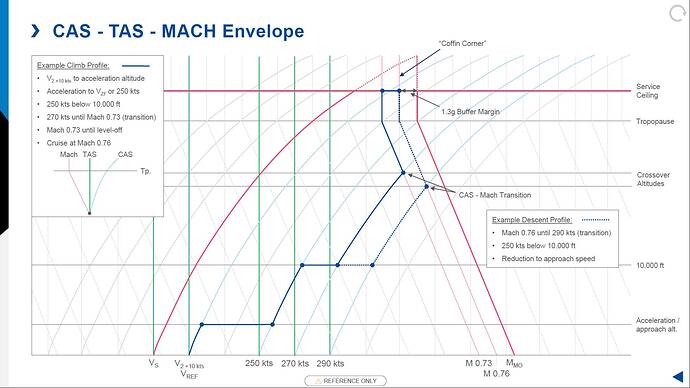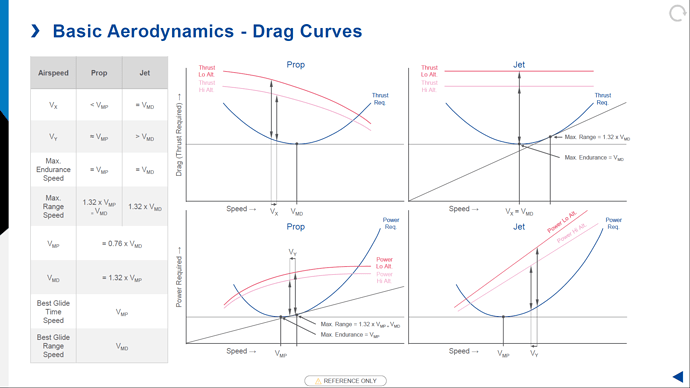Still 300 kts TAS. I just looked at his screenshot, its not even that far below green dot speed, if he is not climbing it means he has reached his absolute ceiling (assuming climb thrust is set). Green dot is more or less the speed for minimum drag which on a jet coincides with the speed for best angle of climb, with increase in altitude the best rate of climb speed reduces until equal to best angle of climb speed = minimum drag speed at the theoretical ceiling. In other words if you want to reach maximum altitude, climb with green dot speed. This obviously isn’t very efficient time or even fuel wise so it has no practical application of course.
Point taken. I’m just not used to moving like a snail. I got it to 376 GS at 38K(probably higher if I was watching it the entire time). That’s pretty slow to me, but maybe that’s just the most the 320 can do that high up.
I don’t know what is standard climb profile on the A320, Eurocontrol performance database states 290 kts until M0.78 as climb profile. In other words, climb with 290 kts until Mach 0.78, then maintain M0.78 until cruise altitude. When climb performance has dropped to 300 ft/min you have reached your operational ceiling.
Some more info on the subject:
https://safetyfirst.airbus.com/control-your-speed-in-cruise/amp/
This doesn’t look like FBW A32NX… It looks like the default Asobo A320 by looking at the spacing of the AP1 FMA, the lack of Selcal plate, and the missing information from the Upper ECAM display.
Judging from the photo, I agree with most people here. The thrust lever is not in THR CLB detent.
Thrust levers in the CLB detent or not, the AP should maintain target speed = 320 kts by lowering the nose when in (managed) CLB mode. So there is definitely a bug in the autopilot logic. But indeed, the FMA indicates THR LVR indicating that both thrust levers are below the CLB detent.
Thrust levers on CL push knop again.
AoA 12° A-Floor protection kicking in soon anyway
This has to be a bug guys. There’s no way I’m only at 180knots with the lever almost all the way up. This is the FlyByWire.
A climb profile that works well is as follows:
Green dot around 200kts during initial turn
250kts to 10,000ft
280 kts until 0.72mach.
Then 0.72 mach to top of climb.
With tailwinds I take off 10kts and with headwinds add 10kts. (Only once above 10,000ft).
Once above FL2800 the air is too thin so you need to stop accelerating in Mach in order to retain climb performance of around 900ft/min.
In real life you would still have around 1500ft/min climb even climbing at 0.74mach. The climb N1 would really climb to around 90% toward top of climb but it doesn’t in the sim.
Actually your Fma modes don’t make any sense to me.
In first row it should say 'THR CLB" and not “THR LVR”
->Wrong Speed mode
Row two should say green “CLB” and a cyan “ALT”
->Wrong Alt mode
When levers not in CL detent your autothrust is in limited mode
Agreed. Per the OP, he’s running it at the max, or close to it. That’s out of the AT range.
This…… is anybody else experiencing the same issue with this plane?
You are the issue.
There is no speed mode engaged. That is what i am telling you. The aircraft tries to climb till it has no speed left and alpha floor Kicks in.
The 320 magenta is the speed constraint programmed in the fmc by the way
Fl350 with pitch of 10° and AOA of 12° , engines are not powerful enough to pull the plane out of this state right know.
Lower the nose let the speed come up. Thrust llevers to cl, choose 290kts and pull the speed knob. After that push it back in (i suggest switch to mach and choose .74 mach instead)
Then choose higher flight level and press the ALT knob
By the way 320 AIS is in Fl350 575Kt TAS which is (ISA conditions) mach 1.0…
Fantastic article!!
Why would you adjust climb profile for wind? The FMC would do that for you when using ECON based on Cost Index, but this 10 kts is not based on anything. So with 100 kts head or tailwind you use the same correction as for a light wind? When flying manually, not using managed modes you usually don’t bother with that. Just climb at best rate if climb speed (green dot + 50 to 70, forgot what it is exactly on the Airbus).
Second changeover from constant CAS to constant MACH is not performed “above FL280”, this is not a fixed thing, its based on your climb profile and temperature. Climbing at higher CAS lowers changeover altitude, climbing at higher MACH increases the changeover altitude. In your example you simply climb with 280 kts CAS until MACH = 0.72, then change to MACH and the same on the way down.
Not specific to the Airbus, but same idea:
Interestingly he is close to green dot speed (meaning min drag) while also close to Vmin, with high nose attitude. Its either completely bugged or wrong weight entered. Its also not the FBW version as far as I can tell.
GD speed is the engine-out operating speed in clean configuration. In other words, it corresponds to the speed that allows the highest climb gradient with one engine inoperative in clean configuration.
In all cases (all engines operative), the GD speed gives an estimate of the speed for best lift-to-drag ratio. It is also the final take-off speed and it represents the operational speed of the clean configuration and the recommended speed in holding in clean configuration. Also known as best glide
It is represented by a green dot on the PFD speed scale and displayed only when the slats / flaps control lever is in the ‘0’ (CLEAN) position and landing gears are not compressed.
So many possible things why it looks so bad on his screen. Weight/balance? Cg in a bad state. Trim /83%?
Can’t tell by the screenshot
Definitely weight or a bug, GD can’t be that close to stalling angle, the low speed cue is AOA based so wrong gross weight would explain the picture, or simply a bug.
Regarding the definition of green dot speed, there is hardly any difference between all engine operating and engine out minimum drag speed (=GD) on a jet. This is more true for a turbojet than for a turbofan, still GD is a great approximation of minimum drag speed either all engines operating or engine-out and also is:
- Speed for best climb gradient.
- Speed for best endurance (holding).
- Speed for best glide range.
With increase in altitude, the best rate of climb speed reduces while the speed for best gradient remains constant (Vmd), at the aircraft theoretical ceiling: Vx = Vy = Vmd.
Also has anyone noticed that the Autobraking is set to “Max”? Didn’t think that was possible to select for cruise/landing.
It’s almost as if the plane has not been fully configured correctly before take off.
You could use MAX for landing but I suspect it has been selected to MAX for take-off (RTO) and it didn’t reset to OFF after take-off. I don’t believe this is the FBW version so its likely full of bugs.
I agree, this is not the FBW version

